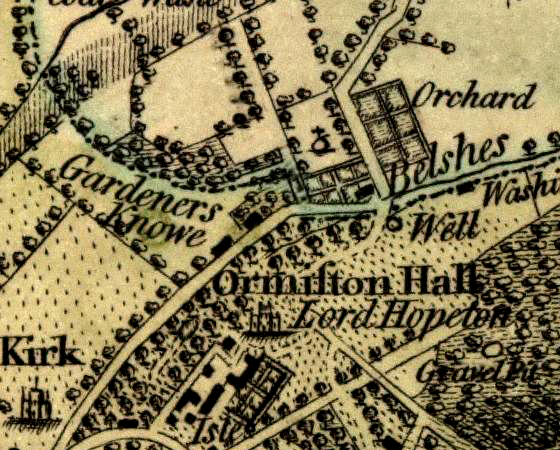

 |
From a map surveyed in 1799. |
||
|
An account from 1846 describes Ormiston Hall:
Ormiston Hall, the residence of the Dowager Countess of Hopetoun, is a handsome mansion, erected by Mr. Cockburn in 1745, near the site of the ancient baronial castle, which has been converted into offices and servants' apartments. It is situated in an extensive and richly-wooded demesne (land kept for the Lord's personal use). The gardens contain every variety of fruits, flowers, and shrubs, and the pleasure-grounds are laid out with great taste and judgment. In the flower-garden are some fig-trees, planted by the then proprietor in the beginning of the last century, and which produce the finest specimens of that fruit in this part of Britain. Also a remarkable yew of more than 200 years' growth, which is still in full vigor, and measures seventeen feet in girth at a height of five feet from the ground. A communion token from Ormiston Kirk (shown in the map above) in Ormiston Parish, Haddingtonshire from 1845:
Communion tokens were often used for admission to a communion service. Sometimes to receive a token, parishioners had to go through religious instruction and payment of a fee. Used in many countries especially in Presbyterian churches of Scotland. Tokens were made of lead or pewter and in round, square, oblong, oval and heart shapes and in sizes from a dime to a dollar. When agricultural activity diminished, stone quarries and coal mining came to prominence. The 1846 account describes the threat that mining posed to the Hall and to the Kirk: The substrata are chiefly limestone and coal, both of which are wrought to a considerable extent, and the latter from a very remote period. The principal vein of coal lies in the grounds of Ormiston Hall, in various parts of which the surface, being undermined, has fallen considerably; and the Hall itself appears to have been much endangered, and rendered secure only by under-building to a very great extent. Upon the south side of the river are three seams of good coal, the uppermost thirty inches in thickness; the second, of equal quality, thirty-three inches; and the lowest, from thirty-three to forty-three inches thick. On the north side of the river the seams are all, with some trifling cross workings, entire. The limestone in the southern part of the parish is wrought, and there are kilns for burning it into lime: freestone of various quality is also abundant. A quarry of freestone which was opened to the north of the Hall, produced stone only of a coarse and easily friable quality; but on the western confines of the parish, another was opened in 1808, of which the stone was more compact and durable, well adapted for building, and used in making additions to the house of Ormiston. (Reference source: A Topographical Dictionary of Scotland, 1846) The reforming preacher George Wishart, companion of John Knox, was captured by the Earl of Bothwell while hiding at Ormiston Hall in 1545. This structure was eventually abandoned and a new Ormiston Hall was built for Cockburn in 1745-48. When he did not achieve the expected return on his investment in his agricultural projects, he sold the Hall to the Earl of Hopetoun in 1747. John Cockburn died in 1758. |

|
Return to ORMISTON PLACES page |
